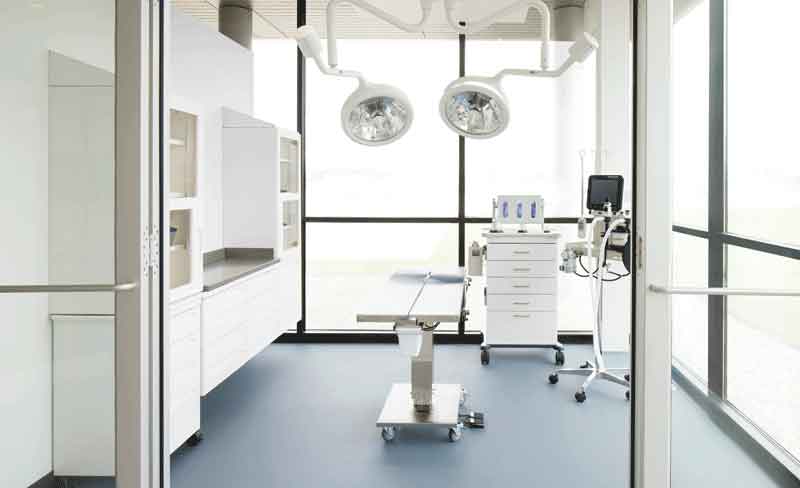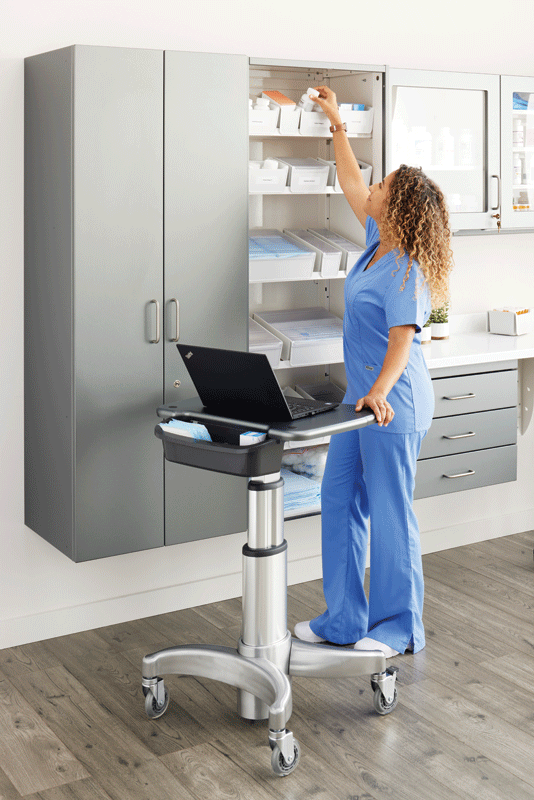
Photos courtesy Midmark
The American Animal Hospital Association (AAHA) recommends limiting surgery suite equipment to essential items. This opens the space to streamline movement and workflow and supports a more sterile environment with fewer surfaces to decontaminate.
With a “less is more” approach, choosing the best solutions to support the way you practice becomes even more important. It is also an ideal time to consider how ergonomics play into the long-term health and safety of your team.
Ergonomics impact staff (and practice) health
In a recent survey of the American College of Veterinary Surgeons (ACVS),1 93 percent of veterinary surgeons were reported to have had experienced musculoskeletal symptoms associated with surgery in at least one body part, with the neck, lower back and upper back frequently affected. Discomfort and pain worsened with prolonged surgical hours.
What would happen to your practice and your patients if you could not operate, even for a short time, because of musculoskeletal injuries?
There are also financial implications for lost work time. The Occupational Safety and Health Administration (OSHA) estimates the average employer pays $35,225 for indirect workers’ compensation costs2 per incident for strain injury. If your practice is operating at the industry-average 15 percent profit margin,3 you would need an additional $234K in revenue to recoup your indirect workers’ compensation costs.
Supporting proper ergonomics may help lessen the risks of occupational injuries. When selecting surgery equipment designed to support care team health and safety, the following are best practice recommendations for your surgery suite essentials.
Adjusting for individual needs and preferences

Repeated bending at the waist or hunching over a surgery table contributes to lower back pain and muscle strain. Ideally, the surgical table should be positioned at a working height that supports a neutral spine, allowing hands, wrists, and shoulders to stay in a relaxed position without overextending. Look for surgery tables with ergonomic features such as:
- Adjustability that allows staff of varying heights to operate in a relaxed position that supports hands, wrists, and shoulders.
- Hydraulic or electric lifts to simplify table-height adjustment with a button press.
- Tilting feature that adjusts the patient position from horizontal to vertical for better reach.
The size of your practice may dictate the number of tables you position within your surgery suite. A minimum of six feet between surgery tables is recommended for workflow efficiency and patient safety.
A compact surgery table may be a better option if you specialize in smaller patients. Adjustable feline surgery tables comfortably support smaller patients throughout surgical procedures, requiring less reach for staff.
In addition to maintaining a neutral position as much as possible, regular breaks to stand, walk, and stretch are important and can help prevent strain and fatigue.
Ensuring flexibility
When selecting anesthesia and monitoring solutions, consolidating equipment and determining placement within the surgery suite can impact staff comfort, safety, and workflow efficiency. Co-mounting anesthesia and monitoring equipment allows you to consolidate devices, creating one central system that occupies less space. Centralized systems can also be easier for staff to manage during procedures, requiring less movement between standalone devices and potentially reducing risks of error.
For equipment placement, wall-mounted and mobile solutions each have their own benefits. Wall-mounted anesthesia and monitoring systems can make a small surgical area feel larger by freeing floor space and stowing when not in use. Alternatively, a mobile system offers the flexibility of being easily moved from one point of care to another.
Regardless of how you choose to position your equipment, staff should be able to see and reach devices without straining or navigating a congested surgical area. Streamlining access to your anesthesia and monitoring system will go a long way toward enhancing care efficiencies.
Enhancing visibility, reach, and efficiency
Limiting surgery suite storage helps keep the suite as clean and sterile as possible. It also minimizes instances of staff entering the suite for supplies when they may not be involved in the current procedure.
When selecting cabinetry that supports better ergonomic reach, consider that strain and sprain injuries occur by repeatedly stretching for out-of-reach supplies. More than 92 percent of veterinary technicians are female4 with an average height of 5 feet, 4 inches.5 Most are using cabinetry positioned too high for their reach.
Cabinetry that positions your supplies at an optimal height and depth improves ergonomic reach and visibility. When coupled with gravity-fed angled flow shelves and accessory bins that keep most-used items within easy view and reach, staff have better visibility and accessibility to supplies, even items stored at the back of the cabinet. The ability to easily view and access also aids in more efficient supply replenishment.
Limiting eyestrain-induced fatigue
Eyestrain can be an issue for surgeons, contributing to headaches, sensitivity to light, and fatigue. Look for surgery lights that provide the reduced-shadow white light you need to properly match shades, identify details, and diagnose tissue.
Counterbalanced dual-lighting fixtures offer exceptional visibility during high-risk procedures, providing increased light intensity for true tissue color and requiring less re-positioning during procedures that can help reduce the length of surgery. Ceiling-mounted options can be easily positioned while freeing floor space and reducing potential clutter around the surgery table.
Utilizing mobile furnishings
While best practice dictates an uncluttered surgery suite outfitted with essential equipment only, there may be instances where your workload or work style may be better supported with a mobile worksurface or seating.
Mobile treatment carts offer added workspace for sterile or used instruments or access to stored surgical supplies. They can be positioned for comfortable, easy access during procedures or removed from the suite when not needed.
To assist with the efficient transfer of patients in and out of surgery, mobile lift tables can be height adjusted to encourage the easy transport of patients while providing a helpful way to limit the patient’s movement after anesthesia.
Similarly, while many veterinarians stand during surgeries, you may want a seating option for longer procedures or dentistry.
A proper surgery chair should support active sitting, allowing you to adjust the height of the chair as well as the back-and-forth motion of the seat tilt and backrest tilt.
Consider the sitting angle as you explore options. In a 90-degree sitting angle, the spine tends to curve inward, compressing the spine. Alternatively, a 120-degree sitting angle allows the spine to expand, following the natural curve of your spine and resulting in a more comfortable, ergonomic position.
When seated for procedures, your knees should slide under a cutout at the front or side of the surgery table for optimal comfort. Ultimately, select surgery chairs that support individualized sitting styles for better posture and spine care.
Bringing the pieces together in practice
Minimal equipment is best practice in a surgical suite, and the equipment you choose can have a lasting impact on your health and safety, as well as the longevity of your career. Ergonomically savvy equipment and furnishings are designed to support proper positioning during procedures, but they can also help enhance clinical efficiency. If you are unsure where to start, your staff, peers, design experts and equipment manufacturers each bring unique perspectives to the table. Through collaboration and shared insights, you can be confident that you will have a surgery suite that supports the health and safety of you and your team and the best possible patient care.
|
HOW FLOW AND MOVEMENT IMPACT EFFICIENCY |
| As you begin to address the equipment you need for your surgery suite, it is also important to evaluate movement patterns within the suite.
Are extra steps needed around the surgery table to access the patient? Can staff move seamlessly between surgery and recovery? Is there a clear path for transporting patients? Evaluate how much movement occurs within your surgery suite to identify workflow habits that could be contributing to staff fatigue, unintentional process workarounds, safety issues and clinical inefficiency. Recognize you do not have to evaluate flow and design the perfect surgery suite by yourself. Clinical design experts can guide you through space design, equipment placement and workflow, helping you create a space that supports better workflow and safety. Lean on industry expertise and peer experiences on your design journey. |
Kelsey Robinson and Stephanie Bertschy are marketing managers for Midmark Animal Health. Robinson drives strategic initiatives for Midmark’s veterinary anesthesia, monitoring and instrument processing solutions. She brings a wealth of knowledge to the veterinary community, advising on anesthesia delivery solutions and equipment best practices. Bertschy, on the other hand, manages product marketing and positioning for veterinary cabinetry and tables. With her extensive workflow expertise, she has helped establish Midmark as a key partner to veterinarians seeking to create efficient spaces and workflows in their care facilities.
References
- Kim S, Yu D, Simons M, Breur G. Prevalence of Work-Related Musculoskeletal Symptoms in Veterinary Surgeons. 2023. DOI: 10.1055/s-0043-1761245 https://www.thieme-connect.com/products/ejournals/abstract/10.1055/s-0043-1761245
- United States Department of Labor. Estimated Costs of Occupational Injuries and Illnesses and Estimated Impact on a Company’s Profitability Worksheet. Retrieved from https://www.osha.gov/dcsp/smallbusiness/safetypays/estimator.html
- iVET360. 2021 Veterinary Industry Benchmark Report.
- https://www.census.gov/library/stories/2019/08/your-health-care-in-womens-hands.html
- https://www.cdc.gov/brfss/annual_data/annual_2018.html
